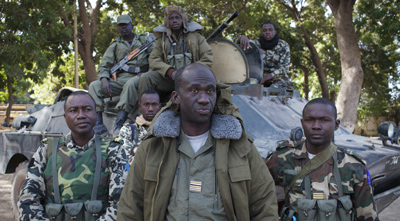The French army is often called la Grande Muette, or “the Great Silent.” The war in Mali confirms the French military’s well-deserved reputation of being secretive about front-line actions. “Locking the information is more in the culture of the French army than of the U.S. army,” says Maurice Botbol, director of La Lettre du Continent. In the first two weeks of military operations against Islamist militant groups in Mali, the French army has released only a blurry video of an air attack at an undisclosed location.
International journalists who have flown to Mali are kept far from the front lines. No journalist has been embedded with the Special Forces that have carried out the first assaults. Most reporters who receive the authorization to accompany the troops are limited to coverage of marginal stories, such as military preparations on the Bamako airport or the “progress of the troops to the North,” very far from the battlefields.
The roads to the North are blocked by a succession of checkpoints manned by the Malian army. “They are very nervous,” says Gérard Grizbec, a reporter with the public service TV channel France 2. “They have received stern orders from the French forces: ‘Don’t let yourself being overtaken by journalists.’ They usually ask us where we’re going, check our passport, and request an accreditation of the Malian Communications Ministry.”
And then they often turn the media away.
“All the reporters that travel to the North come back frustrated and furious to Bamako,” complains Jean-Paul Mari, special envoy for the newsweekly Le Nouvel Observateur. “This is a war without images and without facts.” On January 22, the French channel i>Télé devoted a whole report to the difficulty of reporting. “We try to outwit the Malian army,” says its editor-in- chief, Lucas Menget. “It is like a cat-and-mouse game.” And up to now, it is a losing game for the press.
French journalists have been protesting against this blackout and, despite the dangers of reporting without army protection, have asked to be allowed closer to the front. Still, the specter of abduction looms over the press corps. “I often think about what happened to Hervé Ghesquière and Stéphane Taponier,” says Hugues Huet, special correspondent for the French public service channel France 3. Huet was referring to the two French TV journalists held captive by the Taliban for 547 days in 2010 and 2011 in Afghanistan.
The news director of France Télévisions, Thierry Thuillier, who had to manage the hostage situation, has adopted a strict policy. “The absolute rule is not to cross the front line. It is out of question to try to reach the rebel groups because French journalists are potential targets,” he told the daily Le Figaro. The French army has also been underlining the dangers of abduction and has warned against the adverse effects it could have on the operations and safety of French soldiers.
But many journalists claim the right to assess–and accept–risk on their own. “The military have abandoned the zero-casualty tale,” says Mari. “The tale of zero risk for journalists should also be dropped.”
Others openly express their “suspicions” about the “culture of secrecy” they perceive as surrounding the conflict in Mali. “Do they want to hide something?” asks Sylvain Cherkaoui, a photographer on assignment for the daily Le Monde. Abuses and summary executions have allegedly been committed by the Malian army in some of the towns that have been reconquered. These reports are taken seriously in Paris. If such abuses are confirmed and repeated, they might undermine the support of the French public for the military intervention.
The French operation in Mali demonstrates again that truth is the first casualty of war, but it’s also a reminder that no military force can control the message completely. A photograph by AFP’s Issouf Sanogo, showing a French soldier wearing a skull mask that emulates a character in the video game “Call of Duty,” has forced the French army to come out of the woods and condemn the soldier’s behavior as “unacceptable.”
“The army is taking a big risk in not showing images,” warns Carl Meeus of Figaro magazine. “In any case, some images will inevitably circulate and this will create a risk of boomerang because we well know that a war is never clean.”
